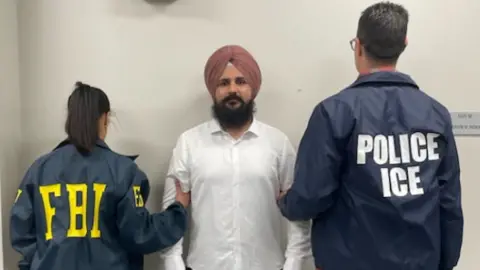Brenton Shar is one of many missing Indigenous men around the country. Why aren't they found?
Search the news, stories & people Personalise the news and stay in the know Emergency Backstory Newsletters 中文新闻 BERITA BAHASA INDONESIA TOK PISIN Topic:Indigenous Australians WARNING: This story contains distressing content. Jimmie Mongoo wears his son's favourite footy shirt while relaxing at home, after long shifts operating a crane at a mine. It's one way he can feel close to Brenton, his 37-year-old son who has been missing for almost a year. "His hobbies were watching the football, especially the Hawks … so I wear it every time I'm home," explained Jimmie, a Wadjarri Nanda man. On May 1, 2024, Brenton Shar vanished from the coastal Western Australia town of Geraldton, about four hours' drive north of Perth. The disappearance of Brenton has devastated his parents, partner Kasey and their two young daughters. Jimmie Mongoo’s son Brenton went missing from their home town of Geraldton in Western Australia. (ABC News: Sissy Reyes) Jimmie's bond with his son had strengthened after Brenton moved back to Geraldton five years ago. Their relationship as adults deepened after a disconnection during Brenton's childhood. Now, Jimmie spends most mornings driving around town looking for any clues that could lead to his son's whereabouts. It's a heartbreaking ritual, but one he can't let go. "It hurts a lot for me to just be doing it every day. Just roaming around by myself. I just break down thinking whether I'm going to find anything or not, and how I will react," Jimmie said behind the wheel of his ute. Jimmie Mongoo is still searching for his son Brenton, who went missing in May last year. (ABC News: Sissy Reyes) Brenton and Kasey had been together for about five years and had two little girls under the age of three. On the night he disappeared, he was staying at his dad Jimmie's house. "Whenever we have a disagreement, he goes to his dad's and cools off and then comes back home," said Kasey, a Yamaji and Nyoonga woman. Kasey and Brenton had been together for about five years when he disappeared. (Supplied) Brenton had dropped past his home with Kasey to pick up some groceries before heading back to his father's. As Kasey said goodbye, she had no reason to think this would be the last time she would ever see her partner. "Last I knew he was watching a movie [at Jimmie's house] and having some food and resting up on the couch," Kasey remembered. There's a moment from that evening that haunts Kasey, a puzzle she'll never be able to unpick. Around midnight, she woke up to go to the bathroom. Brenton’s family say he was last seen near this service station. (ABC News: Sissy Reyes) "My phone was ringing … I answered it, and when I put it to my ear to say hello, there was nothing," she said. "Brenton tried to call me." Kasey tried to ring back, but it went straight to voicemail. Brenton's phone had died. It was about 9pm that night when Brenton left his dad's house with his two nephews to buy cigarettes from the service station down the road, according to Jimmie, who watched him walk down the street. Jimmie says the last time he saw Brenton was walking down this road. (ABC News: Sissy Reyes) Jimmie suspects Brenton may have gone out to buy drugs. He was worried his son's mental health had been going downhill. Not far from the service station, Brenton separated from his two nephews. He never made it back home. The next morning no-one could get in touch with Brenton. He wasn't at home, and his phone was dead. Kasey knew straight away something was wrong. This was totally out of character for the man she loved. "He's a person that always has his phone charged, and he always texts back or rings back … I always knew where he was," she said. Kasey took to the streets that day, driving around town looking for any sign of her partner. Kasey Burns says she and partner Brenton would text every day before he disappeared. (ABC News: Sissy Reyes) "I went out searching everywhere pretty much, searching high and low … but no one's seen Brenton," she said. In those first few days, there are differing accounts of when the family contacted the police. WA Police told the ABC the first record on file of the family raising concerns occurred five days after Brenton went missing. But Jimmie is adamant he went to the police station to report Brenton missing the day after he disappeared and the response was dismissive. "The guy that I was talking to at the counter, the officer there … what I got off him was, who gives a f***, just another blackfella," Jimmie said. "That's it, that's how I felt." Brenton Shar’s family feel they were treated dismissively by local police. (ABC News: Sissy Reyes) The distraught father said the police assumed Brenton had "just wandered off" and was "visiting friends". Relief came to the family when they heard Brenton had been spotted in town, information that Jimmie shared with the police. Brenton Shar was 37 years old when he disappeared in Geraldton, WA, one night last year. (Supplied) But this turned out to be false hope, and two days later when Brenton was still nowhere to be found, the family raised the alarm again with the police. By this time, Brenton had been missing for eight days. As the days rolled by with still no sign of Brenton, his partner Kasey desperately continued to follow every possible lead. "I couldn't sit home without getting up and coming down and searching. I couldn't sit, couldn't rest," Kasey said. When she heard someone thought they'd seen him by the beach around the time he went missing, she searched there. Kasey Burns says she searched day and night for her missing partner. (ABC News: Sissy Reyes) "I decided to go over on the rocks, have a look all around. Then I got here, and I found his shorts," said Kasey through tears, standing on the beach for the first time since the difficult discovery. "I was just looking and started singing out for Brenton. I just felt like my soul left my body." Kasey was hopeful this clue would lead to some answers, calling the police straight away. At this point, Brenton had been missing for 11 days. It took another nine days for police to confirm through CCTV and witness accounts that Brenton was wearing similar shorts the night he disappeared. A pair of missing man Brenton Shar’s shorts were found by the beach in Geraldton. (ABC News: Sissy Reyes) Police divers arrived from Perth the following day to search the area, but they didn't find Brenton. At this point, Brenton had been missing for three weeks. Then she got a call from police, who told her the search had been unsuccessful and they were back to square one in their search for Brenton. "When [the police] rang me and told me on the phone, I just broke down," she said. After Brenton Shar disappeared, his family drove the streets of Geraldton looking for him. (ABC News: Sissy Reyes) Kasey remembers the last conversation she had with detectives. "All the evidence they have leads into the ocean," Kasey said. But to Kasey, this is just another painful detail that doesn't add up. Brenton wasn't a fan of the beach. "I've never known Brenton to go to the beach by himself … not at night time," she said. Brenton's loved ones are not only Indigenous family searching for a missing loved one. After a cluster of Indigenous men had gone missing in Western Australia, in July last year families in South Hedland and Broome organised a "Let's Bring Them Home" protest, calling for more government and police resources to help find them. Kasey and Jimmie joined in, leading a protest march through their hometown of Geraldton. Jimmie hopes that by raising awareness, they can help other families struggling through the same ordeal. Hundreds of people marched in Broome in July last year, calling for answers after the disappearance of several Aboriginal men in Australia's north-west in recent years. (ABC Kimberley: Mya Kordic) "And for other people to notice," he added. Indigenous men are over-represented in long-term missing persons cases in comparison to non-Indigenous men in almost every Australian state and territory that records this data. At least 150 Indigenous men are missing long-term across the country — but the true number is likely much higher, as this figure does not capture every jurisdiction. In NSW and the ACT, the police could not supply the ABC with data, both citing the challenges to accurately record the Indigenous status of a missing person. Without this vital data, it's impossible to determine the full scale of the problem. Greens Senator Dorinda Cox argues the collation of Indigenous status would help to understand the problem, and in turn, guide preventative action to do something about it. "We don't actually know why they're going missing. Missing data is a key part of understanding what the drivers are. When we are trying to figure out what is a big jigsaw puzzle, essentially, we need the data to inform that," said Senator Cox, who established the Senate inquiry into Missing and Murdered First Nations women and children that concluded last year. "In my experience, what that means is that the family then go looking for their own answers. They are self-funding rallies and searches, which in 2025 is just unacceptable in a country as rich and as progressive as Australia." Senator Cox says there's a story attached to every person that disappears. (ABC News) Senator Cox is now calling for a federal investigation into missing Indigenous men. "If we continue to ignore this, what is the impact that's happening for successive victims and also their families?" Remembering the people behind the numbers — brothers, sons, fathers, partners, friends, nephews, uncles and cousins who are loved and missed drive the senator's call for an inquiry. There are at least 150 Indigenous men missing long-term across Australia, however there could be more. (Supplied) "Every statistic is a person, a person that is part of a family, that's part of a community … there's a story that's attached to that," Senator Cox said. "There's a story about their life that they've lived and their life that every one of their family members, their community members, would have wanted for them." Brenton Shar’s family describe him as “full of laughter and fun”. (Supplied) Jimmie Mongoo remembers Brenton not as a missing person, but as a man who loved his family. "He's very loving, full of laughter and fun, always wanted to joke with his family and friends and everything, and most of all, he really loved his children," he said. Brenton was close with his two older brothers, Jesse and Derek. "The three of them grew up together… couldn't tell them apart. They used to be called the three amigos because they were always together," he said. Jimmie misses Brenton desperately and often sits on the verandah with a cup of tea, hoping his son will one day wander up the street, and return home. Jimmie Mongoo describes his sons as the "three amigos", who were always together. (ABC News: Sissy Reyes) Tucked away in a lab in Canberra among hills and ridges with walking trails, forensic teams from the Australian Federal Police have what they say could be the key to solving some of those long-term missing persons cases. The potential for closure rests with the more than 700 unidentified human remains currently held by police and coroners around Australia. "We're finding every day, sadly, for whatever reason, members of the public may come across items, be concerned that they could be of human origin," said Joanne Cameron, who is Acting Assistant Commissioner and Commander of Forensics for the AFP. Commander of Forensics for the Australian Federal Police Joanne Cameron says more missing persons cases could be solved by analysing unidentified remains. (ABC News: Sissy Reyes) Over a four-year period up to 2024, the AFP's National DNA Program examined 99 unknown human remains, solving 19 long-term missing persons cases, however none are believed to be Indigenous people. "A majority of those cases were actually solved through DNA analysis, so matching [a] DNA profile which was recovered from the remains against reference samples that were provided by the families of the missing persons," said forensic biologist Michelle Spiden. Forensic biologist Michelle Spiden says missing persons cases have been solved through DNA analysis. (ABC News: Sissy Reyes) Federal government funding for the DNA testing program ended last year. The remains will now only be examined on a case-by-case basis when requested by police or coroners. "As we work towards helping identify those human remains … I have no doubt we will find closure on some of our long-term missing persons cases," Ms Cameron said. "The unambiguous loss that families feel while they wonder what happened to their loved one can never, ever be understated." Brenton's father and partner continue to search and hope, but the emotional toll is high. "As his father, I felt like it should have been my thing to find him," Jimmie said during one of his searches for his son. Brenton's partner Kasey shared her heartache, knowing her two girls will grow up without their dad. "He was a fun dad, always playing and interacting with the girls," she said. Brenton’s family say his young daughters still wonder where he is. (Supplied) Their two and three-year-old daughters aren't quite old enough to understand that Brenton most likely isn't coming home, said Kasey. They still ask where their dad is hiding. "They're wondering where Dad is because they always look for him in the house. They look for him still," she said. Jimmie describes his granddaughter searching for Brenton under the beds. "She came up and grabbed me by the face, and just stared in my eyes and said, 'look, Pop, where is he now?'" he said, with a sad laugh. WA Police told the ABC's Indigenous Affairs Team that from the time the family first raised welfare concerns, it conducted "extensive inquiries" into Brenton's whereabouts, which included patrols, drones, and reviewing CCTV. "Many hundreds of investigative actions have been and continue to be undertaken by police to determine Mr Shar's whereabouts," it said in a statement. In those crucial early days, Jimmie felt there was little communication from the police. Jimmie Mongoo says he felt there were gaps in communication from police. (ABC News: Sissy Reyes) "I've never really had any information that they were doing all this stuff, and as far as I'm aware, myself and my family were doing it all," Jimmie said. WA Police told the ABC in a statement that it remained committed to finding answers for families of missing persons and provides regular updates to families throughout an investigation via phone and in-person meetings. With additional reporting by Madi Chwasta. Topic:Unrest, Conflict and War Topic:Elections Analysis by Jacob Greber Topic:Voting Topic:Education Topic:Drug and Substance Abuse Topic:Missing Person Topic:Indigenous Australians Geraldton Indigenous Australians Missing Person Topic:Unrest, Conflict and War Topic:Elections Analysis by Jacob Greber Topic:Voting Topic:Education Topic:Voting Analysis by Chris De Silva Topic:Arts, Culture and Entertainment Topic:Comedy We acknowledge Aboriginal and Torres Strait Islander peoples as the First Australians and Traditional Custodians of the lands where we live, learn, and work. This service may include material from Agence France-Presse (AFP), APTN, Reuters, AAP, CNN and the BBC World Service which is copyright and cannot be reproduced. AEST = Australian Eastern Standard Time which is 10 hours ahead of GMT (Greenwich Mean Time)


















